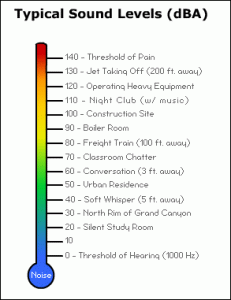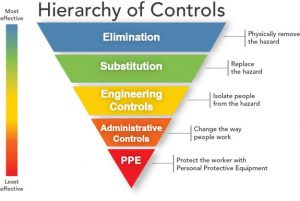Whether working at a manufacturing facility, an active construction site, or a concert hall, routine exposure to elevated noise levels in the working world poses potentially adverse health effects. Hearing loss can have a major impact on an individual’s quality of life beyond on-the-job productivity. It may be difficult to communicate and socialize with others, and can impact one’s ability to cognitively focus on his or her surroundings. Fortunately, hearing loss is preventable through responsible planning and use of personal protective equipment (PPE).
In the United States, the Occupational Safety and Health Administration (OSHA) sets legal limits with respect to noise exposure in the workplace. Noise is measured in units called A-weighted decibels (dBA), which represent the magnitude of sound pressure. The term “A-weighted” refers to how the human ear, specifically, perceives loudness. See the table below for an example of dBA ratings for common sources of noise:
The permissible level of exposure (PEL) for each worker set by OSHA is 90 dB for an 8-hour work day, while the National Institute for Occupational Safety and Health (NIOSH) recommends an equivalent of 85 dB exposure for the same time period. When considering sound levels, it is essential to understand that decibel values are measured logarithmically. For example, a sound level of 100 dBA is 10 times louder than a sound level of 90 dBA.
If the source of the noise cannot be eliminated or modified, three methods can be used in conjunction to minimize the effects of elevated noise in the workplace:
- Engineering Controls – Physical changes to reduce work exposure, including equipment modification and replacement, or altering the path of sound transmission. Some examples are: adding an enclosure to a piece of machinery or placing sound-absorbing panels on the ceiling.
- Administrative Controls – Changes in workplace logistics to limit worker exposure to sound. Examples include increasing the distance between workers and the noise source, and strategically planning or rotating employee shifts to reduce noise exposure.
- PPE – Ear plugs and ear muffs can attenuate sound, and can even be worn concurrently to achieve a greater level of noise reduction.
The figure below details the hierarchy of controls as outlined by NIOSH, ranking noise reducing methods from most to least effective. Changes in the workplace should be prioritized in that order, with elimination being the preferred option, and PPE being the least effective choice. It is important to note that even when worn properly, the effectiveness of PPE is limited. PPE is often referred to as the “last line of defense” when it comes to noise mitigation. For example, a combination of high-quality ear plugs and ear muffs worn together may only reduce the dBA rating by a maximum of 15 decibels. A jackhammer or power drill may reach 130 dBA, and in order to properly protect a worker, reducing the dBA to 115 over an 8-hour workday is not enough; this is where other more effective controls must be implemented to ensure a safe workplace.
Walden Environmental Engineering is staffed with professionals that can assist in managing your workplace or construction site health and safety concerns. Please give us a call at (516) 624-7200 to learn more.


